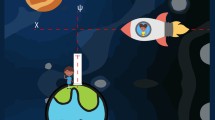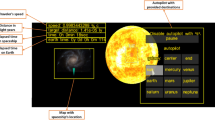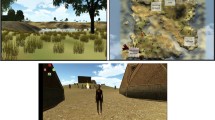Abstract
Learning in immersive 3D environments allows students to collaborate, build, and interact with difficult course concepts. This case study examines the design and development of the TransGen Island within the SciEthics Interactive project, a National Science Foundation-funded, 3D virtual world emphasizing learning science content in the context of ethical dilemmas. The 2 year development process is examined through the lens of the rapid prototyping instructional design model, following the project from conceptualization to implementation of a 3D simulation. Through expert interviews, focus groups, and working groups, we were able to determine critical scientific and ethical issues to present to learners in the virtual world. We collected data on 53 students using the simulation at universities in the United States and South Africa and evaluated their experience using qualitative and quantitative methods. Results showed that student participants were engaged and motivated by the simulation. The students reported an increase in science knowledge and ethical understanding, but individual experiences varied.




Similar content being viewed by others
References
Alperstein, N. (2011). Can you develop virtue in a virtual world? Teaching advertising ethics in second life. In ICERI2011 Proceedings (pp. 2533–2542).
Barab, S. A., Sadler, T. D., Heiselt, C., Hickey, D., & Zuiker, S. (2010). Erratum to: Relating narrative, inquiry, and inscriptions: Supporting consequential play. Journal of Science Education and Technology, 19(4), 387–407.
Batane, T. (2010). Rapid prototyping for designing and delivering technology-based lessons. Educational media and technology yearbook (pp. 45–55). New York: Springer.
Beard, L., Kumanan, W., Morra, D., & Keelan, J. (2009). A survey of health-related activities on second life. Journal of Medical Internet Research, 11(2), e17.
Committee on Science, Engineering and Public Policy (CSEPP). (2009). On being a scientist: A guide to responsible conduct in research, 3rd ed. Washington, D.C.: National Academy of Sciences, National Academy of Engineering, and the Institute of Medicine of the National Academies, The National Academies Press.
DeHann, R. (2005). The impending revolution in undergraduate science education. Journal of Science Education and Technology, 14(2), 253.
Desrosier, J. (2011). Rapid prototyping reconsidered. Journal of Continuing Higher Education, 59(3), 135–145.
Dorsey, L., Goodrum, D., & Schwen, T. (1997). Rapid collaborative prototyping as an instructional development paradigm. In C. Dills & A. Romiszowski (Eds.), Instructional development paradigms. Englewoods Cliffs: Educational Technology Publications Inc.
Edmonds, G. S., Branch, R. C., & Mukherjee, P. (1994). A conceptual framework for comparing instructional design models. Educational Technology Research and Development, 42(4), 55–72.
Hai-Jew, S. (2011). Virtual immersive and 3D learning spaces: Emerging technologies and trends. Hershey: Information Science Reference.
Hannah, S., Avolio, B., & May, D. (2011). Moral maturation and moral conation: A capacity approach to explaining moral thought and action. Academy of Management Review, 36(4), 663–685.
Helton-Fauth, W., Gaddis, B., Scott, G., Mumford, M., Devenport, L., Connelly, S., et al. (2003). A new approach to assessing ethical conduct in scientific work. Accountability in Research, 10, 205–228.
Hew, K., & Cheung, W. (2010). Use of three-dimensional (3-D) immersive virtual worlds in K-12 and higher education settings: A review of the research. British Journal of Educational Technology, 41(1), 33–55.
Hickey, D. T., Ingram-Goble, A. A., & Jameson, E. M. (2009). Designing assessments and assessing designs in virtual educational environments. Journal of Science Education and Technology, 18(2), 187–208.
Hollander, R. (2009). Ethics education and scientific research: What’s Been learned? What should be done? Report of a workshop. Washington, D.C.: National Academies Press.
Houser, R., Thoma, S., Coppock, A., Mazer, M., Midkiff, L., Younanian, M., et al. (2011). Learning ethics through virtual fieldtrips: Teaching ethical theories through virtual experiences. International Journal of Teaching and Learning in Higher Education, 23(2), 260–268.
Jones, M., Li, Z., & Merrill, M. (1992). Rapid prototyping in automated instructional design. Educational Technology Research and Development, 40(4), 95–100.
Jones, T., & Richey, R. (2000). Rapid prototyping methodology in action: A developmental study. Educational Technology Research and Development, 48(2), 63–80.
Lang, A., & Bradley, J. C. (2009). Chemistry in second life. Chemistry Central Journal, 3(1), 14.
Mayer, T., & Steneck, N. (2012). Promoting research integrity in a global environment. Singapore: World Scientific Publishing.
McArthur, V. (2008). Real ethics in a virtual world. In CHI’08 extended abstracts on Human factors in computing systems (pp. 3315–3320). ACM.
McCabe, D. (2005). It takes a village: Academic dishonesty. Liberal Education, 91(3), 26–31.
Mumford, M., Connelly, S., Brown, R., Murphy, S., Hill, J., Antes, A., et al. (2008). A sense making approach to ethics training for scientists: Preliminary evidence of training effectiveness. Ethics Behavior, 18(4), 315–339.
Nichols-Casebolt, A. (2012). Research integrity and responsible conduct of research. New York: Oxford University Press.
Piskurich, G. (2011). Rapid instructional design: Learning ID fast and right. Hoboken: Wiley.
Rappert, B. (Ed.). (2010). Education and ethics in the life sciences strengthening the prohibition of biological weapons. Canberra: ANU E Press.
Rest, J. (1979). Development in Judging Moral Issues. University of Minnesota Press.
Second Life. (2012). Destination guide: Science and technology. Retrieved August 13, 2012, from http://secondlife.com/destinations/science.
Smith-Doerr, L. (2006). Learning to reflect or deflect? U.S. politics and graduate programs’ ethics training for life scientists. In S. Frickel & K. Moore (Eds.), The new political sociology of science: Institutions, networks and power (pp. 405–431). Madison: University of Wisconsin Press.
Speight, J., & Foote, R. (2011). Ethics in science and engineering. Hoboken: Wiley.
Steneck, N. (2004). Standards of ethical standards of conduct: Introduction to the responsible conduct of research. Washington, DC: Department of Health and Human Services, Office of Research Integrity.
Steneck, N. (2009). The ORI introduction to the responsible conduct of research. Washington, D.C.: Department of Health and Human Services, Office of Research Integrity.
Steneck, N. (2013). Global research integrity training. Science, 340(6132), 552–553.
Tice, D. (1992). Self-concept change and self-presentation: The looking glass self is a magnifying glass. Journal of Personality and Social Psychology, 61, 659–669.
Titus, S. (2010). Tie funding to research integrity. Nature, 466(22), 436–437.
Titus, S., Wells, J., & Rhoades, L. (2008). Repairing research integrity. Nature, 453(19), 980–982.
Tripp, S. D., & Bichelmeyer, B. (1990). Rapid prototyping: An alternative instructional design strategy. Educational Technology Research and Development, 38(1), 31–44.
Warburton, S. (2009). Second Life in higher education: Assessing the potential for and the barriers to deploying virtual worlds in learning and teaching. British Journal of Educational Technology, 40(3), 414–426.
Weston, T., Seymour, E., & Thiry, H. (2006). Evaluation of science education for new civic engagements and responsibilities (SENCER) project. Prepared for SENCER/National Center for Science and Civic Engagement.
Wimpenny, K., Savin-Baden, M., Mawer, M., Steils, N., & Tombs, G. (2012). Unpacking frames of reference to inform the design of virtual world learning in higher education. Australasian Journal of Educational Technology, 28(3), 522–545.
Woody, W. D. (2008). Learning from the codes of the academic disciplines. New Directions for Higher Education, 142, 39–54.
Wright, D., Titus, S., & Carnelison, J. (2008). Mentoring and research misconduct: An analysis of research mentoring in closed ORI cases. Science and Engineering Ethics, 14, 323–336.
Wrzesien, M., & Alcañiz Raya, M. (2010). Learning in serious virtual worlds: Evaluation of learning effectiveness and appeal to students in the E-junior project. Computers and Education, 55(1), 178–187.
Acknowledgments
This research was supported by the National Science Foundation EESE Program Award No. 0932712.
Author information
Authors and Affiliations
Corresponding author
Appendix 1
Rights and permissions
About this article
Cite this article
Nadolny, L., Woolfrey, J., Pierlott, M. et al. SciEthics Interactive: science and ethics learning in a virtual environment. Education Tech Research Dev 61, 979–999 (2013). https://doi.org/10.1007/s11423-013-9319-0
Published:
Issue Date:
DOI: https://doi.org/10.1007/s11423-013-9319-0




